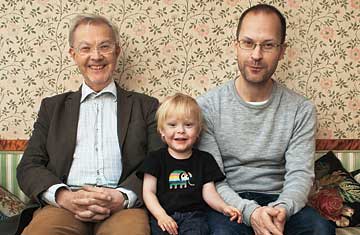
Three generations: Dr. Lars Olov Bygren, with son Magnus and grandson Ludvig in Stockholm
(7 of 8)
When Pembrey, Bygren and Golding looked at the sons of those 166 early smokers, it turned out that the boys had significantly higher body mass indexes than other boys by age 9. That means the sons of men who smoke in prepuberty will be at higher risk for obesity and other health problems well into adulthood. It's very likely these boys will also have shorter life spans, just as the children of the Overkalix overeaters did. "The coherence between the ALSPAC and Overkalix results in terms of the exposure-sensitive periods and sex specificity supports the hypothesis that there is a general mechanism for transmitting information about the ancestral environment down the male line," Pembrey, Bygren, Golding and their colleagues concluded in the European Journal of Human Genetics paper. In other words, you can change your epigenetics even when you make a dumb decision at 10 years old. If you start smoking then, you may have made not only a medical mistake but a catastrophic genetic mistake.
Exploring Epigenetic Potential
How can we harness the power of epigenetics for good? In 2008 the National Institutes of Health (NIH) announced it would pour $190 million into a multilab, nationwide initiative to understand "how and when epigenetic processes control genes." Dr. Elias Zerhouni, who directed the NIH when it awarded the grant, said at the time--in a phrase slightly too dry for its import--that epigenetics had become "a central issue in biology."
This past October, the NIH grant started to pay off. Scientists working jointly at a fledgling, largely Internet-based effort called the San Diego Epigenome Center announced with colleagues from the Salk Institute--the massive La Jolla, Calif., think tank founded by the man who discovered the polio vaccine--that they had produced "the first detailed map of the human epigenome."
The claim was a bit grandiose. In fact, the scientists had mapped only a certain portion of the epigenomes of two cell types (an embryonic stem cell and another basic cell called a fibroblast). There are at least 210 cell types in the human body--and possibly far more, according to Ecker, the Salk biologist, who worked on the epigenome maps. Each of the 210 cell types is likely to have a different epigenome. That's why Ecker calls the $190 million grant from NIH "peanuts" compared with the probable end cost of figuring out what all the epigenetic marks are and how they work in concert.
Remember the Human Genome Project? Completed in March 2000, the project found that the human genome contains something like 25,000 genes; it took $3 billion to map them all. The human epigenome contains an as yet unknowable number of patterns of epigenetic marks, a number so big that Ecker won't even speculate on it. The number is certainly in the millions. A full epigenome map will require major advances in computing power. When completed, the Human Epigenome Project (already under way in Europe) will make the Human Genome Project look like homework that 15th century kids did with an abacus.
